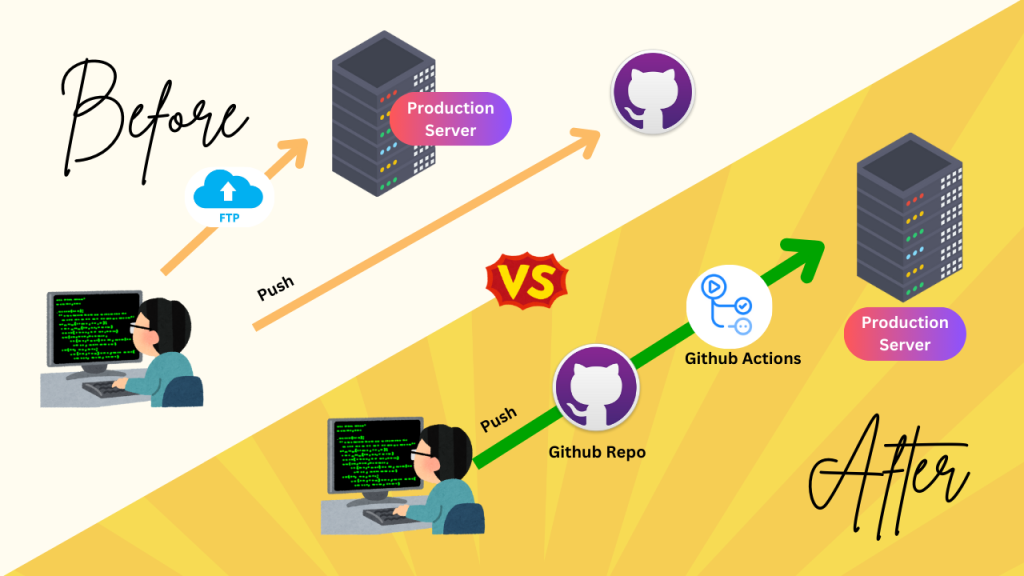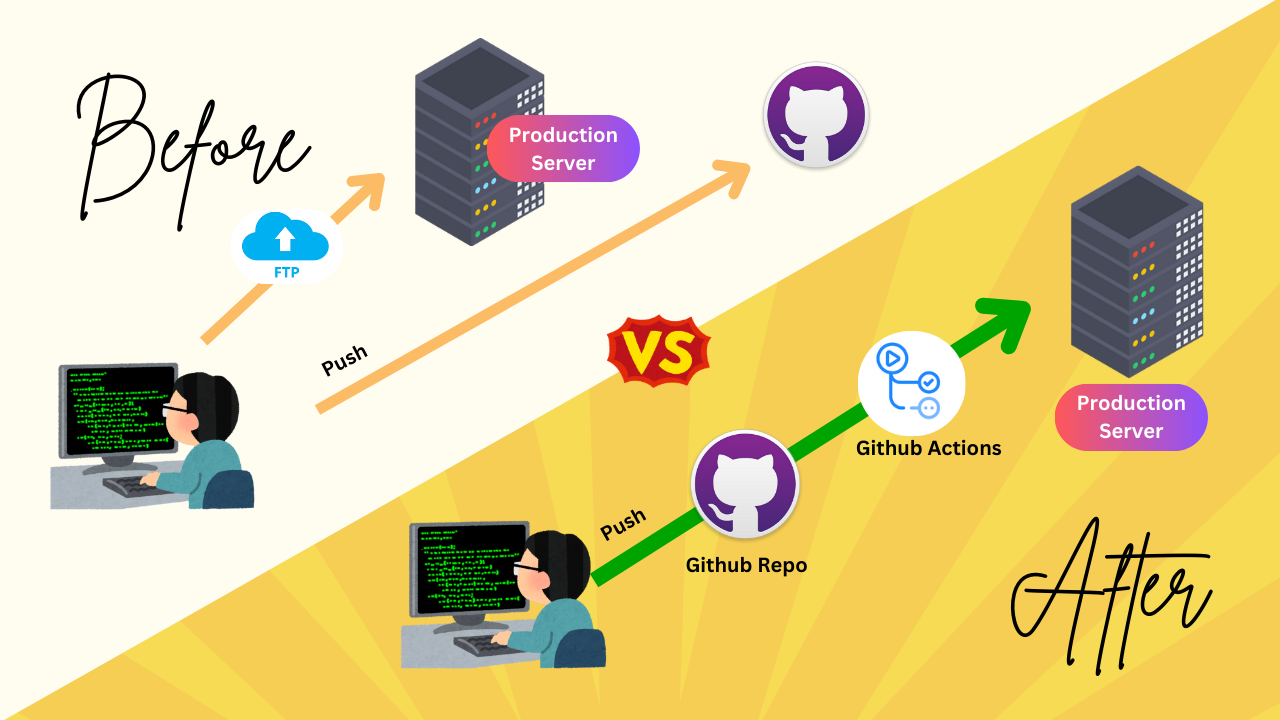In this article
A Seamless Guide to Automating Deployment with GitHub Actions
This guide will walk you through how I use GitHub Actions to automate deployment with my team, saving time and streamlining our project deployment.
Introduction
What is Continuous Deployment?
Imagine a world where deploying updates isn’t a hassle but a smooth, automatic process. That’s what Continuous Deployment (CD) brings to the table. Let’s break it down:

Manual Deployment:
This can be tedious and error-prone.
Typically, in PHP development, you build on your local server, commit changes to GitHub, and then manually transfer these changes to the production server using SFTP/FTP/SSH.
Continuous Deployment:
With Continuous Deployment, you set up a pipeline through GitHub Actions. This automation kicks in whenever you push to GitHub, deploying your changes directly to your production server.
It’s like magic—only it’s real!
Why Embrace Continuous Deployment?

Instant Updates:
One click, and your changes are live. No more worrying about FTP transfers or manual uploads.
.

Consistency and Reporting:
Track who made what changes and when. It ensures order and helps resolve conflicts efficiently.

Transparent Changes:
Direct changes via FTP can be messy. With Git, every change is tracked, reducing the risk of overwritten updates.

Multi-Location Deployments:
Deploy your project to multiple locations effortlessly. Whether it’s libraries, reusable code, or different projects, it’s all just a step away.

Easy Rollbacks:
Made a mistake? Git has you covered. Roll back changes seamlessly with just a few commands.

Enhanced Security:
Store sensitive information like usernames and passwords securely in GitHub Secrets. Team members can deploy without accessing these secrets directly.

Flexibility:
Edit and deploy from anywhere. If something needs fixing, just log in to GitHub and make changes on the fly.
My Experience with GitHub Actions
Challenges:
I used to face issues where team members would forget to update Git and made changes directly on the live server. Tracking these changes was cumbersome.
Solution:
GitHub Actions transformed this process. It made deployment easier and tracking issues within Git commits straightforward. For my VueJS projects, I added a build step with npm run build, eliminating the need to manually set up builds before deployment. It’s almost instant and incredibly efficient.
What Are GitHub Actions?
Think of GitHub Actions as a smart assistant that automates your repetitive tasks. Here’s a quick overview:
1. Automate Tasks:
GitHub Actions handles tasks like testing code, building projects, and deploying apps automatically. For instance, it can run tests every time you push new code.
2. Workflows:
These are sets of instructions for GitHub Actions, telling it what tasks to perform and when. For example, a workflow can trigger tests and builds whenever new code is pushed.
3. Triggers:
Triggers are events that start workflows. Common triggers include code pushes, pull requests, or issue creation.
4. Jobs and Steps:
- Jobs: Groups of tasks that run on virtual machines.
- Steps: Individual tasks within each job, executed in sequence.
How to Use GitHub Actions
1. Create a Workflow File:
Add a file named .github/workflows/main.yml in your repository.
2. Write Your Instructions:
Here’s a sample workflow file:
name: CI
on: [push]
jobs:
build:
runs-on: ubuntu-latest
steps:
- name: Checkout code
uses: actions/checkout@v2
- name: Set up Node.js
uses: actions/setup-node@v2
with:
node-version: '14'
- name: Install dependencies
run: npm install
- name: Run tests
run: npm test3. Commit and Push:
Save and push the workflow file to your repository. GitHub Actions will handle the rest based on your triggers.
Why Use GitHub Actions?
- Save Time: Automate repetitive tasks.
- Catch Errors Early: Run tests automatically to identify bugs.
- Streamline Work: Simplify your development process and make it more efficient.
Step-by-Step Guide
1. Setup a GitHub Repository:
Create your repository on GitHub.
2. Get Your SFTP/FTP Credentials:
Acquire the access details for your production server.
3. Create GitHub Actions:
Set up your workflows to automate deployment.
The following is a workflow which I use to build my VueJS project and SFTP both the PHP Code files and VueJS build files to my production server.
on: push
name: 🚀 Deploy on on teampro new
jobs:
deploy-master:
name: "Deploy to Master Branch"
runs-on: ubuntu-latest
timeout-minutes: 30
steps:
- name: Checkout Repository
uses: actions/checkout@v4
with:
fetch-depth: 0
- name: 🔨 Build Project
run: |
cd todo23/teamprotodo_vue/
npm install
npm run build
- name: Deploy Files
uses: milanmk/actions-file-deployer@master
with:
remote-protocol: "sftp"
remote-host: ${{ secrets.DEPLOY_HOST }}
remote-user: ${{ secrets.DEPLOY_USER }}
ssh-private-key: ${{ secrets.DEPLOY_PRIVATE_KEY }}
remote-path: "/home/bitnami/htdocs/teampro/new2"4. Deploy:
Watch as your changes go live automatically.
How to Scale:
As your projects grow, scale your workflows to handle multiple deployments and environments.
Conclusion
Embracing Continuous Deployment through GitHub Actions has streamlined my workflow and made managing deployments a breeze. It’s practical, secure, and a real time-saver. I highly recommend integrating it into your development process.
Development and Consultation Services
Need a developer? I offer services starting at $15 per hour, scaling up to $30 per hour based on project complexity. If you need website development or want me on your team, reach out to me at shishir.raven@gmail.com.
- Hire Me
- Ask a Question
About the Author:
Passionate about development and innovation, I am always eager to tackle new challenges and help others achieve their goals.
If you enjoyed this article, please give it a clap or share it with others!


